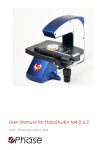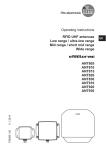Download Engelholm audio Solo User manual
Transcript
Solo User Manual - High Fidelity Loudspeaker engelholm audio manual.indd 2 2012-01-29 15.20 About engelholm audio solo solo - more than just sensitive To re-live the full dynamics of good music you need a loudspeaker – like solo – with great efficiency. solo's outstanding 95 dB/W*m gives you both the dynamics that music deserves, as well as the freedom of choice when it comes to amplifier. During research and development, solid state amplifier have dominated the stage but low watt valve amplifiers have also taken an important part during voicing. solo's high impedance creates good conditions for any amplifier and allows you to put the signature sound you like. But solo's benefits does not end with just high efficiency; music is built based on much more than dynamics. Micro-details, spaciousness and tonality are a few examples necessary in music. solo's line array configuration is an important design concept to fulfil these needs. Line array minimizes the room's negative floor/ceiling effect, thanks to the special radiation pattern derived. To further more enhance your listening experience, the cabinet design uses a CNC milled non-parallel wall structure technique (NPWS). NPWS reduces internal standing waves which guarantees the uncoloured release of the music. NPWS breaks up standing waves in the midrange area which otherwise would have coloured voices and a majority of instruments. Sound pressure is a result of membrane area and length of movement. solo's line array consists of 9 ceramic 6.25 inch bass/midrange drivers. The combined membrane area is greater than one 18 inch driver but with the precision and speed from smaller drivers. Compared to a book shelf speaker, solo's drivers only have to do 1/9 of the job compared to the single driver. The bass/midrange team up with a true ribbon tweeter which have a membrane area 3 times greater than ordinary dome tweeters. The result is distortion free, effortless music - with any amplifier. A few words about cross over. All 9 drivers work equally and cross over to the ribbon tweeter at 2300 Hz, featuring a semi 2nd order cross over. Important cross over goals are controlled dispersion, tonality, easy load and phase linearity. All engelholm audio products are manufactured in Sweden. The workers in the wood shop, the lacquer shop and assembly/quality check all work under good conditions, which ensures both good quality and a sustainable business. In the lacquer shop, more than 25'000 cubic meters, that is 25'000'000 litres, of air is replaced every hour and is compliant with Volatile Organic Compounds (VOC) rules. Table of Content About engelholm audio solo.........................................................................................1 Congratulations..........................................................................................................2 About this Owners Manual...........................................................................................3 Five steps to get solo playing.......................................................................................3 Connection instructions...............................................................................................3 Matching electronic components with solo.....................................................................4 Room Acoustics..........................................................................................................5 Three quick steps to better room acoustic ................................................................5 Advanced Acoustics................................................................................................6 The Three Sweet Spots...............................................................................................6 Odd number rule....................................................................................................7 Toe-in...................................................................................................................7 Tilting...................................................................................................................7 Care of solo...............................................................................................................8 Trouble shooting.........................................................................................................8 Technical Data...........................................................................................................8 Impedance of solo......................................................................................................9 Quality checked......................................................................................................9 Appendix "How to unpack".........................................................................................10 Congratulations We would like to take the opportunity to congratulate you on your solo! We are certain you will enjoy solo and the music you will be able to re-perform in your listening room. The performance from speakers in general and high end speakers like solo in particular, is proportional to the amount of attention given to installation. Thus we urge you to carefully read and practice this Owners Manual. solo features today’s most advanced speaker technology and the special care specified in this Owners Manual will make sure your time together with solo will be for life! Yours sincerely // the engelholm audio team by engelholm audio Revision A www.engelholmaudio.com Page 2(11) About this Owners Manual At engelholm audio we share your enthusiasm for music and hifi equipment. We understand that you want to get started as soon as possible. That is why this manual have two different parts; one part with basic information allowing you to get started quickly. The other part is an in depth information, such as room effects, acoustics, tips as well as technical specifications. Five steps to get solo playing 1. Unpacking solo is best handled by two persons due to its weight ans size. solo is well protected in its shipping case and it is easy to handle the cases with a hand forklift. Thus we recommend you to unpack solo in the room solo is intended to play in. Please see Appendix "How to unpack"Fel: Det gick inte att hitta referenskällan on page 10 for detailed unpack instructions. 2. Positioning Position solo with symmetry in the room and with some distance to the side and rear walls. Start with at least 0.5 m/2 ft. Listening position is also important. The distance to solo should be greater than the distance between the speakers. Please see The Three Sweet Spots on page 6 for more details on positioning solo. 3. Connection Connect solo to your amplifier. Make it a routine to turn off all electronics before doing anything with any cables. Use only quality cables and keep the lengths at a minimum. Please see Connection instructions on page 3 for more details on connecting solo to an amplifier. 4. Burn in Mechanical systems such as loudspeakers are subject to change during a so called burn in period. This regards rigidity of the surrounding, glued parts must find their fit, etc. Burning speaker is done by playing "sound", possibly music. There are commercial alternatives that accelerates the process. There is also a psychological element in the equation; human hearing adjusts to the new sound, adapts itself. solo's 9 ceramic bas/midrange drivers load shares the total sound pressure level (SPL) between them. This is a good thing for the sound (reduced distortion), but burn in takes more time or requires higher SPL. HINT: By switching the polarity of one speaker, low frequency is cancelled out into some extent which might be desirable during burn in. Do not forget to change back to correct polarity once burned in. We recommend 300 hours burn in, but notice that the time is dependant on SPL and type of signal (/music). 5. Tuning the system This is a complex topic covered by the compound of all the chapters. To summarize this: find the three sweet spots, find the matching electronic components and create a listening room that helps the speakers excel in performance. Be creative, be patient. Connection instructions solos terminal's are connected in positive polarity, i.e. a positive signal into the positive terminal forces the drivers to move outwards, towards the listener. We strongly recommend you to check the polarity of the electronics; some electronics by engelholm audio Revision A www.engelholmaudio.com Page 3(11) invert phase, others comply with different connections in XLR cables, etc. Consult the manual of your amplifier. First, connect your speaker cables with solos terminals. The terminals take fork, banana and raw cables. We recommend fork. Second, connect the speaker cables in your power amplifier. Make sure that all cables (interconnect, speaker, digital and power cables) are placed neatly. Avoid different cables being placed in parallel. If cables must cross each other, make it a 90 degrees crossing. Matching electronic components with solo solo is a very true-to-the-signal speaker. This implies that all surrounding components must be of the best quality available. Selecting components is not about compensating one and another’s flaws but rather to gain synergies. Signal source is no exception and we strongly recommend high quality Red Book, SACD, DVD-A, computer based as well as turntable. The source of enjoyment is an area where there is a lot of development going on, with streaming high-def music as one example. A high quality Red Book CD or vinyl is always a good reference in this interesting field of new musical possibilities. A pre-amplifier may come in many shapes; a pre-amplifier could be integrated into a CD player, be a part of an all digital computer based solution or a more traditional electronic box. The role of a pre-amplifier is to act as an interface towards its clients, the CD player, the RIAA, the DAC, etc. On the other hand it must provide the amplifier with a perfect signal and possibly doing so by long interconnect. Surprisingly enough – a pre-amplifier sets a distinct finger print to the sound and this component must not be neglected. Power amplifier (or simply amplifier) is the engine that drives the solo. As mentioned before, the high sensitivity and high impedance gives you a freedom of choice when it comes to amplifier. solo works well from 10 watts up to 300 watts. Being a true-to-the-signal speaker, the amplifier's sound characteristics will affect the resulting sound, allowing you the tweak the final touch. And by the way: Quality watt triumphs quantity watt while Quality quantity watt is the best! Cables are a highly debated topic but at engelholm audio we are in no doubt that cables impact the sound: for good or worse. Cables should preferably be short, at least 1.00 mm²/17 AWG in cross section area and made with pure materials. by engelholm audio Revision A www.engelholmaudio.com Page 4(11) Room Acoustics The single most affecting component of the sound is the room your system is placed in. One could very well argue that the room is a part of the system. We believe so. Some say 50% of the sound quality lies in room properties. The next issue is that different speaker technologies (horn, bi-polar, di-polar, omnipolar, line array, etc.) require somewhat different room properties. But there are more similarities than differences. From the real world, you may recognise the different sound of your own voice in a tiled bathroom compared to a cosy filled-with-fabric master bedroom. Same voice, different sound. All due to room acoustic. engelholm audio constructs and designs room acoustics – a very important area to master if one are to build high performance speakers. Sound reproduction in domestic rooms is a fascinating topic just by the fact that wavelengths span from 30 meters (/115 ft) to 0,017 meter (0,06 ft) in the audible range. Not surprisingly, the waves behave differently depending on wave length but also room size. Long waves, bass tones, are handled by wave acoustic while the higher frequencies are referred to as geometrical acoustic. Being different by nature, the two acoustical types require different treatment technologies. Acoustical properties have been known to man for a long time and the word it self origins from Greek: ἀκουστικός (akoustikos), meaning "of or for hearing, ready to hear" and that from ἀκουστός (akoustos), "heard, audible". But here is a legacy problem. Way back then, the rooms did not look like today’s domestic rooms. In the old days, acoustic was all about reverberation (RT60) and how fast sound dies. More recent studies show that human hearing decodes reproduced sound better if the sound dies in a good way as opposed to just dies fast. It is more interesting how the sound dies. We now know that sound must not die too fast and that the so called energy time decay should have certain ideal properties to gain maximum fidelity. Three quick steps to better room acoustic There are a few things you can do with, or more precisely in, your room that is beneficial for your sound. 1 • Make sure you have furniture in your room. The opposite, a room with no carpet, no shelves, no paintings, no table, no sofa, no nothing is first of all not a nice place to be in, but more important (from this manual's perspective) is that it will have a poor sound. Make sure your room is none compliant with today, 2011, interior design trends. Make sure your room have an interior. • Find1 the first reflection points from your solo; where is it on the side walls, back wall and wall behind listening position? Make sure these reflection points are not a flat, hard wall. Place books here, a painting, some shelves or maybe some curtains. Be extra mindful if the points are windows. Think hard if you can position solo in another way. • Is your room quiet or noisy? Do what ever you can to create a listening environment that is quiet! For example there are doors with better damping properties, shutting out outside noise. If you are in the position to build your room you can use double layers of gypsum board (or such) to make the walls more efficient dampers. Make Use a mirror to locate reflection points. Let another person hold the morror flat against and move it around the wall. When you can see solo reflected in the mirror from listening position the mirror is placed at a reflection point. by engelholm audio Revision A www.engelholmaudio.com Page 5(11) sure you have the alternative to switch off any machines and/or mechanical ventilations. Consider this: how can you hear the finest musical details if your noise floor is high? Advanced Acoustics Books, shelves and paintings are much better than nothing, but they in turn are nothing compared to properly designed acoustical products. So what is a "properly designed acoustical product"? Think of them as mirrors, although the analogy limps a little! The acoustical products will create a (acoustical) mirror image of your speaker. How do you prefer that image to be? A smaller version of the speaker? A brighter one? A darker? A bluer one? A taller one? A wider one? We are convinced that the image should be a replica of your speaker. This implies that properly designed acoustical products are highly effective in a large frequency band. There are for instance coefficients describing the absorptive efficiency as well as coefficients for the diffusing efficiency. Often a number between 0 and 1 which should be read as 0.5 equals 50% efficiency. Sometimes the number is greater than 1.0 and this is a good signal for testing the sales people! Ask them how the product can absorb more than 100% of the sound! The answer is that not only the surface facing outwards is included in the calculation but also the sides of the absorber. Got another answer? Look for another product or sales man. Another good thing to look for is any recommendations as to how near the product you can sit. Some recommendations say "recommended distance is more than 1.0 meter/3 ft". Again – perfect opportunity to ask sales person a question as to why! For diffusers the answer often is that the diffuser has a strong lobe effect. This is a contradiction - diffusers must not have peak lobe, they should diffuse the sound! A good diffuser is the one you can sit close to, closer than a 0.3 m / 1 feet! Around a certain frequency, depending on room volume and reverberation time, wave lengths change in nature. This is usually referred to as Schroeder frequency (2000 √ (T/V)). This is a transition, not a distinct frequency. In practice this is the shift above which diffusers are used and below which bass absorbers are used. In normal rooms this is between 100 and 500 Hz. The problem gets worse the lower the frequency. The solution to low frequency problems spells Helmholtz absorber. Efficiency is tightly connected to the size of the Helmholtz. All other bass absorber types are poor in efficiency and not recommended. We recommend properly designed diffusers on the walls and ceiling2, at reflection points. This will clear up the mids and highs at the same time as creating better 3D image. Corners are often the perfect place for Helmholtz bass absorbers, but measurements are very helpful not to say necessary. The Three Sweet Spots To get the best performance out of solo, you must locate the three sweet spots and position your listening positioning and your solo speakers there. This is a task with cm / ½-inch precision. Solo is designed to be placed some distance away from walls. The radial room mode (“standing wave”) will add bass into the tonality. Decrease the bass by increasing distance from wall behind solo. 2 Ceiling reflection is not as important for solo thanks to dispersion pattern. by engelholm audio Revision A www.engelholmaudio.com Page 6(11) Odd number rule You can place solo according to the odd number rule. Odd numbers are 1, 3, 5, 7, 9 and so on. Let the length of your room be L. Odd number rule says that you should try these different distances from solo3 to the back wall: L/3 or L/5 or L/7, L/9... Example: your room measures 6 meters in length. We divide 6 by 3 we get 2. This means, place solo 2 meters from back wall. Listen. Then try 6/5 which puts solo 1.2 meters out from the back wall. The same methodology goes for listening position. Without experience this is a pure work of trial and error but guarantees good result. Toe-in Solo's high and mid frequency range can be adjusted by what is called toe-in or on/off axis listening. Toe-in is done by angling solo so that they aim at the listener. If your preference wants e.g. a warmer, laid back sound we recommend that solo is not angled at listening position. Even so, you have two options: either to angle solo in parallel with the side walls or to angle solo heavily so that solos axis cross in front of listening position. Tilting Solo can also be tilted to fit different listening heights. Lower the front feet and raise the back feet to fit a lower listening height. 3 Measured from solos front baffle. by engelholm audio Revision A www.engelholmaudio.com Page 7(11) Care of solo solo is made out of wood, a natural material. Natural materials will always come to life when humidity and/or temperature changes. Therefore, solo must be placed in controlled environment (indoors) and out of direct sunlight. If solo is delivered at a time when temperature differences between outside and indoors is great, we propose that solo is kept in shipping boxes for a few hours in the room, so that temperature and humidity adjust slowly. A smooth, damp cloth is perfect to dust and clean solo. Use it on the artificial leather, the wood, terminals and aluminium feet. Do not use it on the drivers other than carefully at the metal basket. A duster may be gently used on the drivers to remove dust. WARNING: Under no circumstances do not use any chemical substances due to risk of damaging the materials on solo. Trouble shooting One channel is not operating If you switch speaker cables from left-to-right, is problem transferred to the other channel? If YES, check all interconnect- and speaker cables. If problem still remains, check electronics. Imaging is not centric Are both solo playing? If NO, see above bullet. Is YES, positioning of solo must be symmetrical in geometry as well as the room must be symmetrical (in terms of dimension, furniture, etc.). Some recordings have an image not centre aligned. Exaggerated highs Toe in increases the highs and with solos line array ribbon tweeter also listening position hight is crucial. Small distance to (side) walls with hard, flat surfaces is bad for sound. Increase distance and treat the walls acoustically. Exaggerated lows Is the ribbon tweeter working? If NO, contact your dealer. If YES, then there might be an acoustical problem or a problem with all to bad amplifier. Try positioning solo with greater distance from the wall behind them. Technical Data Dimensions Weight Crossover Impedance Sensitivity: System Frequency response 1770 x 220 x 680 (Height x Width x Depth [mm]) 85 kg 2nd order 2300 Hz. 8 ohm. See graph. 95 dB/W*m. Ported reflex system. 354-40'000 Hz. 4. In room response much deeper thanks to close boundary effect. 20-25 Hz is common as low frequency cut off in domestic homes. by engelholm audio Revision A www.engelholmaudio.com Page 8(11) Impedance of solo Measured impedance response of solo 11002a/b. Quality checked ------------------------------------- ------------------------------------- Pär Engelholm Anders Andersson by engelholm audio Revision A www.engelholmaudio.com Page 9(11) Appendix "How to unpack" Our goal has been to make it possible for ONE person to "get the solo playing". It is a 99% reality. We want solo to be easy for you to pack and unpack, so that this task is an easy task at fairs/exhibitions and demo’s. To unpack solo, the shipping box must be raised up, so that solo is in fact is standing up. The shipping boxes are marked which end is what (Feet, respective top of solo). Raising the box requires two persons due to weight. Ask the delivery guy for help! Once raised, the top is dismantled. Now you can see solo from the front. Extract the small brief case containing the Finite Elemente. Remove but do not throw away the styropor. Gently roll out solo. Place solo in its room and remove the protective plastic. by engelholm audio Revision A www.engelholmaudio.com Page 10(11) The wheels makes it easier to try out positioning in the room, but do decrease the sound quality. The wheels are simply screed to the legs of solo and are easy to dismantle - but again we strongly recommend this as a two persons task. by engelholm audio Revision A www.engelholmaudio.com Page 11(11) engelholm audio 371 32 Karlskrona Sweden Web: www.engelholmaudio.com Email: [email protected] Phone: +46 (0)70-3976259






















